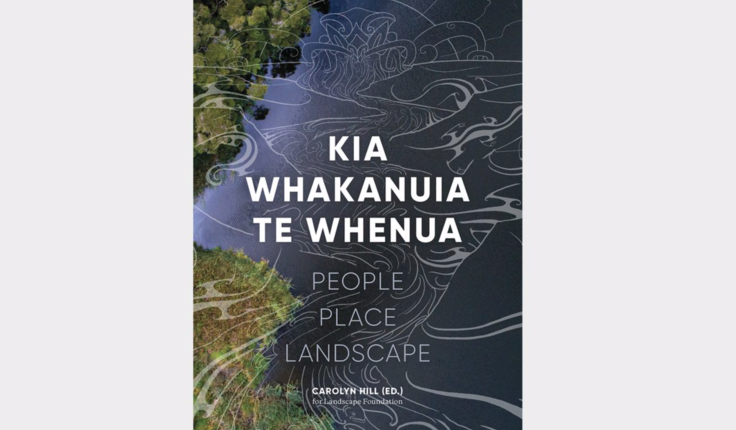News
Highlighting Māori thinking
Posted 10 06 2021
in News

A recent book by the Landscape Foundation brings Māori perspectives on landscape to the fore.
With Kia Whakanuia te Whenua: People, Place, Landscape, New Zealand’s Landscape Foundation has produced a deeply rigorous and challenging book with an overtly optimistic and generative tone, which deserves to be read widely by landscape architects. The book provides a rich documentation of the landscape and culture of Aotearoa through an examination of place and placemaking policy. It’s interwoven structure, with seven chapters and 34 essays, stories, photo essays and polemical pieces, provides a template for the expression of place through publication. This approach foregrounds Māori perspectives, voices and authorship and draws from beyond traditional landscape disciplines.
For the non-Indigenous landscape architect, the real power and challenge of this book lies in its demand upon the reader to understand and reflect upon their own place within each of the essays – and the collection as a whole. Avoiding the epistemological trap of relying on one’s own previous frame/s of reference to make sense of new ways of thinking about the world is difficult and, on my initial reading of the book, I found myself drawing equivalence between Māori concepts and familiar landscape architectural research principles. This need for conceptual equivalence extended to thinking about Australian Indigenous concepts of Country, with their emphasis on connection. The place here, however, is Aotearoa. There are principles at play from which we can learn but the place and the concepts are of that place; we must bring ourselves to that place rather than attempt to bring that place to ours. While there are areas of the book that tend to support this tendency towards equivalence, overall, the book mitigates against this, both demanding and facilitating the placing of oneself in it.
Haare Williams opens with a powerful evocation of colonization and the havoc wreaked on Māori culture as a result, but also brings us to confront the continuing power of language in abetting, embedding and solidifying colonial power structures to the detriment and desecration of Indigenous authority, ideas and practices. The relationship between thought and language forces the reader to take personal responsibility, with consequences for the future of the nation; for Williams, the need for truth-telling is critical for “democracy to prosper.”
Diane Menzies builds on this in her introduction, working across some familiar markers of “landscape” practice, foregrounding an approach that transcends the old binaries (nature/culture etc.) and inviting an engagement with time that grounds non-linear approaches and attitudes to the world. In doing so, she sets the book up to go beyond mere recognition and acceptance that “social justice and equity aligns with recognizing the range of … world views” to show how a deep understanding of these worldviews on their own terms is a precursor to action. In this way, social justice and equity are then embedded in the outcomes of such actions. Herein lies an existential challenge for the landscape architecture profession.
Early in the first chapter, “Wairua o te Whenua,” Alayna Renata writes of the “researcher’s trap of wondering what specifically to write about” in relation to “the spirit of landscape.” Abandoning the academic viewpoint (and quite arguably, the landscape perspective), she draws on her experience, as a Māori woman, of wairua (soul or essence)1 and whenua (land)2 to question the very possibility that academic research might have a role in developing an understanding of the concept of the spirit of landscape. Instead, she calls for recognition of this spirit as being a “lived and living knowledge … articulated through experience.” She captures an overarching point of the book: that “we can learn a lot from what people say they experience.”
Kia Whakanuia te Whenua: People, Place, Landscape. Edited by Carolyn Hill for the Landscape Foundation. Mary Egan Publishing, 2021.
Footnotes
1. wairua – spirit, soul, essence. From the glossary. The book’s glossary is wonderful, as with any glossary however it should be treated with caution and seen as a starting point for understanding – much nuance and particularity can be lost otherwise.
2. whenua – land. From the glossary.
3. whakahāngai – to make the connection. From the glossary.
Review
Published online: 7 Jun 2021
Words: Jock Gilbert
Landscape Architecture Australia, May 2021
14 Apr
NZILA Board nominations close tonight

Read the insights from current Board members
What does the current Board have to say about this opportunity? REMINDER: Board Nominations close tonight, 14 April, 11.59pm We …
08 Apr
Update from Environmental Legislation Working Group
RMA Reforms and NZILA Wānanga
Our understanding of Spatial Planning and in creating well-functioning environments is more deeply considered than simply green fluff - the …
02 Apr
Follow up from the virtual IFLA World Council (22 and 23 March)

Did you attend the virtual IFLA World Council held last weekend? Presentations and ReportsThese can be found here. RecordingFor those …
Events calendar
Full 2025 calendar